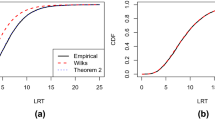Abstract
Current computer programs for analyzing linear structural models will apparently handle only two types of constraints: fixed parameters, and equality of parameters. An important constraint not handled is inequality; this is particularly crucial for preventing negative variance estimates. In this paper, a method is described for imposing several kinds of inequality constraints in models, without the necessity for having computer programs which explicitly allow such constraints. The examples discussed include the prevention of Heywood cases, extension to inequalities of parameters to be greater than a specified value, and imposing ordered inequalities.
Similar content being viewed by others
References
Bentler, P. M. Multistructure statistical model applied to factor analysis.Multivariate Behavioral Research, 1976,11, 3–25.
Bentler, P. M., & Weeks, D. G. Linear structural equations with latent variables.Psychometrika, 1980,45, 289–308.
Jöreskog, K. G. Estimation and testing of simplex models.British Journal of Mathematical and Statistical Psychology, 1970,23, 121–145.
Jöreskog, K. G. Structural equation models in the social sciences: Specification, estimation and testing. In P. R. Krishnaiah (Ed.),Applications of statistics. Amsterdam: North-Holland, 1977.
Jöreskog, K. G., & Sörbom, D. Statistical models and methods for analysis of longitudinal data. In D. J. Aigner & A. S. Goldberger (Eds.),Latent variables in socioeconomic models. Amsterdam: North-Holland, 1977.
Jöreskog, K. G., & Sörbom, D.LISREL IV: Analysis of linear structural relationships by the method of maximum likelihood. Chicago: National Educational Resources, 1978.
Lawley, D. N., & Maxwell, A. E.Factor analysis as a statistical method. London: Butterworth, 1971. (2nd Edition)
Lee, S. Y. Estimation of covariance structure models with parameters subject to functional restraints.Psychometrika, 1980,45, 309–324.
McDonald, R. P. A simple comprehensive model for the analysis of covariance structures: Some remarks on applications.British Journal of Mathematical and Statistical Psychology, 1980,33, 161–183.
Werts, C. E., Linn, R. L., & Jöreskog, K. G. Estimating the parameters of path models involving unmeasured variables. In H. M. Blalock, Jr., (Ed.),Causal models in the social sciences. Chicago: Aldine, 1971.
Wismer, D. A., & Chattergy, R.Introduction to nonlinear optimization: A problem solving approach. New York: North Holland, 1978.
Author information
Authors and Affiliations
Additional information
Work on this project was aided by the City University of New York—Professional Staff Congress Research Award Program Grant Number 13631.
Rights and permissions
About this article
Cite this article
Rindskopf, D. Parameterizing inequality constraints on unique variances in linear structural models. Psychometrika 48, 73–83 (1983). https://doi.org/10.1007/BF02314677
Received:
Revised:
Issue Date:
DOI: https://doi.org/10.1007/BF02314677



